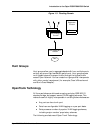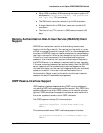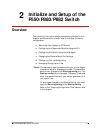
1-22
Chapter 1
Cajun P550R/P880/P882 Switch User Guide
PER VLAN Spanning Tree Protocol Option
Per-VLAN mode is the Default Spanning Tree setting on all three
switches. In this mode, the switch runs a separate spanning process
for each VLAN. Each logical Spanning Tree has its owns Per-VLAN
BPDU's which are tagged with the appropriate VLAN Identifier(s).
Under this mode, the switch can participate in as many Spanning
Tree Domains as there are VLANs defined on the switch. This
conforms to a "virtual" bridging model where the switch runs as if
each VLAN is a separate logical bridge (separate Address Forwarding
Tables, separate spanning trees, etc.). If spanning tree is not required
on all VLANs, you can disable it for individual VLANs on a VLAN by
VLAN basis. Also, different root bridges can be configured with
different bridge priorities based upon VLAN. This will allow load
sharing to occur based upon VLAN. Similarly link costs and priorities
can be adjusted on a per-VLAN basis allowing further load sharing
per VLAN.
Per VLAN Spanning Tree is the recommended method whenever
many VLANs are passed over interswitch links, but not every VLAN
reside on every interswitch link. If IEEE 802.1D Spanning Tree
mode is used without care under these constraints, VLANs can be
split due to blocking on inappropriate links. The only time that Per-
VLAN mode may become undesirable is when you have more
VLANs to manage than the number of Spanning Tree Domains. The
only other constraint is to limit the number of outgoing BPDUs.
It is required that the number of outgoing BPDUs be less than 500/
second on all three switches. This means that if you have 50 VLANs
you cannot have more than 20 possible paths back to the root bridge
(50 VLANS X 20 LINKS X 0.5 BPDU/sec. = 500), or if you have 100
VLANs you cannot have more that 10 possible paths back to the root
bridge. These constraints are not generally exceeded in real
networks. If these limits are exceeded, you must use 802.1D
Spanning Tree mode.
This method can easily inter-operate with legacy IEEE802.1D
Devices. The Legacy Devices become part of the VLAN associated
with the VLAN port binding with which they are attached. In other
words, if there are 3 P550’s in a network running VLANA and
VLANB, and three legacy devices connect up through a port
configured in VLAN A, the legacy devices will become part of the
VLAN A Spanning Tree. The P550’s will participate in two Spanning
Tree domains, one for VLAN A containing three bridges and one for
VLAN B containing 6 bridges. The legacy devices need not be VLAN
aware.


















